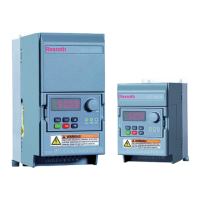Transmission
The transmission is of RTU (Remote Terminal Unit) mode with frames containing
no message header or end mark. A typical RTU frame format is shown below:
Slave address Function code Data CRC
1 byte 1 byte 0...252 byte(s) CRC low|CRC high
Tab. 14-1: Typical RTU frame format
● Data are transmitted in binary codes.
● CRC: Cyclic redundancy code.
● The address 0 is reserved as broadcast address.
● All slave nodes must recognize the broadcast address for writing function (no
need of reply).
● The master node has no specific address, only the slave nodes must have ad-
dresses (1...247).
For RTU transmission mode, four types of character format are shown below:
● 1 start bit, 8 data bits, 1 stop bit, no parity
● 1 start bit, 8 data bits, 1 stop bit, even parity
● 1 start bit, 8 data bits, 1 stop bit, odd parity
● 1 start bit, 8 data bits, 2 stop bits, no parity
The character or byte is sent in the following sequence (from left to right):
<-Least significant bit (LSB)
Most significant bit (MSB)->
Start 1 2 3 4 5 6 7 8 Stop –
Start 1 2 3 4 5 6 7 8 Even Stop
Start 1 2 3 4 5 6 7 8 Odd Stop
Start 1 2 3 4 5 6 7 8 Stop Stop
Tab. 14-2: RTU transmission mode
Message frames are separated by a silent interval of at least 3.5 characters'
time. The entire frame must be transmitted as a continuous stream of bytes. If
the interval of two separated frames is less than 3.5 characters' time, then the
slave address of second frame will be treated as the part of first frame by mis-
take, due to the confusion of the frames, the CRC check will fail and lead to
communication fault. If a silent interval of more than 1.5 characters' time occurs
between two bytes, the message frame is regarded incomplete and discarded by
the receiver.
Bosch Rexroth AG
Communication
EFC x610 Series
258/389
DOK-RCON03-EFC-X610***-IT05-EN-P

